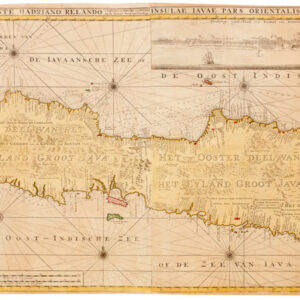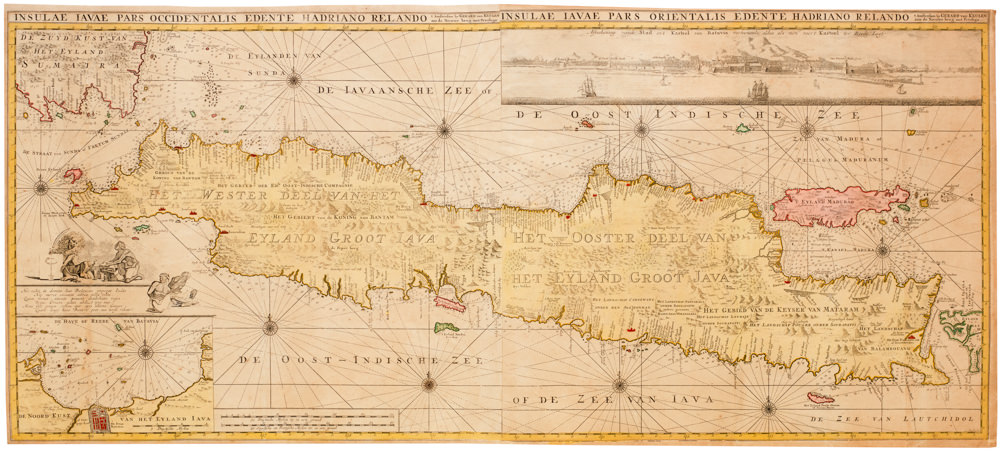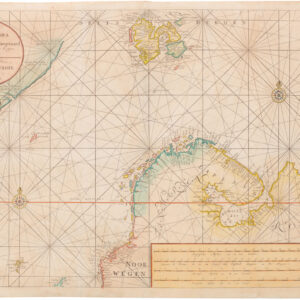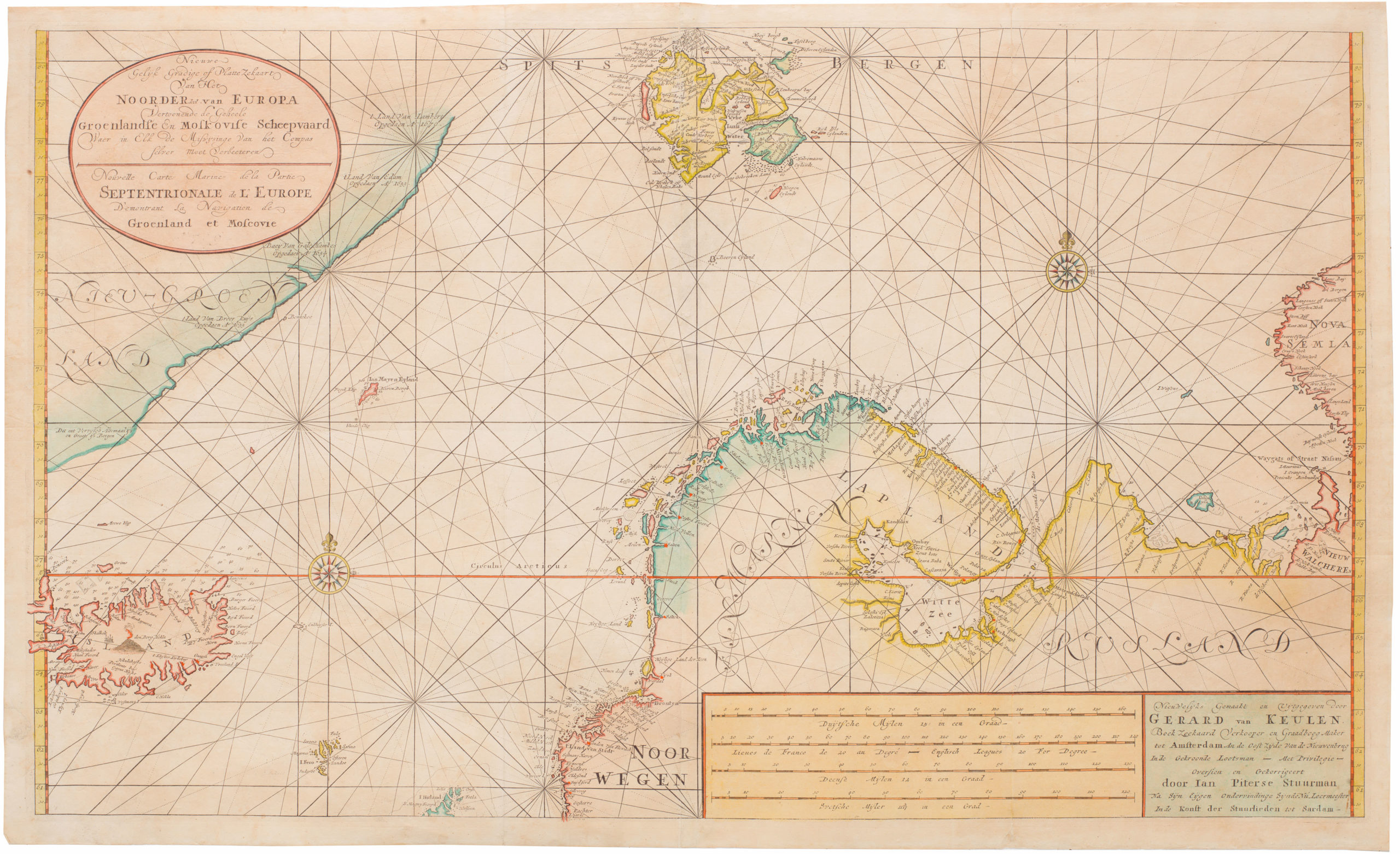Johannes van Keulen (1654-1715) was a Dutch cartographer born in Deventer and operating from Amsterdam in the 17th and early 18th centuries. He created several important nautical atlases and pilot guides, the most famous of which were his Zee-Atlas and the five-volume nautical guide, Nieuwe Lichtende Zee-Fakkel (New Shining Sea Torch). Johannes van Keulen established his business – In the Gekroonde Lootsman (In the Crowned Pilot) – in 1678, and within a few years he acquired both a partner in Claes Janzoon Vooght and a protective patent for his charts. The latter not only allowed him to publish and print maritime atlases and guides, but also meant that the Dutch State protected his published charts from being replicated without permission.
As many of Van Keulen’s works were wholly original maps designed specifically for Dutch nautical use, creating them came at considerable expense. The protection offered by the patent was therefore a crucial legal precondition for the success of his business. But it was also a symbolic cementation of Holland’s independent rights as a nation. Together, Vooght and Van Keulen created a massive five-volume nautical atlas entitled Nieuwe Lichtende Zee-Fakkel, which was published from 1681 to 1684 and contained over 130 completely new nautical charts. It was, at the time, the most comprehensive and up-to-date maritime atlas available on the market. As such, it had a huge impact in Dutch nautical circles and would eventually help secure the cartographic reputation and esteem of his son, grandson, and great grandson.
The first volume of the Zee-Fakkel focused on northern Europe, with charts of the North and Baltic Seas, the Gulf of Finland, St. Petersburg, Denmark, Norway, and the Scandinavian coast up to Archangel in northern Russia. The second volume dealt with the western shipping routes, especially along the English Channel, and along the coasts of Flanders, France, Spain, and Portugal. The third volume covered the Mediterranean from Gibraltar to Turkey. All three volumes were hugely influential and quickly became the dominant guide for maritime trade.
The fourth and fifth volumes of the Zee-Fakkel were dedicated to Holland’s early interests outside Europe, in particular in North America, the Caribbean and Brazil. Here too, shipping routes and trade were paramount and the latter volumes constituted an important tool for the Dutch West India Company operating throughout these waters in late 17th century. It was in a later edition of the fifth volume that this spectacular chart of Java was first published.
Johannes van Keulen’s son, Gerard Van Keulen (1678-1726), was a talented engraver and mathematician who apprenticed with his father and took over the business in 1714. He continued working along the lines of his father, using his notes and charts as the basis for creating new editions of his their important volumes. But he also expanded these works by exploring the new territories gradually opening up in the east and west. To accomplish this, he cultivated new relations with cartographers, traders, mariners, and Company-men.
In order to build his own reputation, Gerard van Keulen drew on his father’s publications, patent rights and position in Dutch society. He nevertheless also cultivated new partnerships, which included the Dutch East India Company. Gerard van Keulen’s close ties to the Company meant he had access to their otherwise closely guarded archives. The charts and notes from hundreds of mariners found in this vast repository formed the basis for new and revised maps of Asia, which soon became renowned throughout Europe for their accuracy. The most important of these was of course his chart of Java, the crown jewel of the Dutch colonial empire.
Finally, he secured his position by winning the necessary privileges that had allowed his father to build the business in the first place. The importance of this is underlined in the upper right corner of the map, which contains the mapmaker’s name and emphasizes his status as privileged (met Privilegie).
The van Keulen dynasty was continued for several generations with Johannes II (1704-1755) adding further maps of Asia to his grandfather’s atlas and Gerard Hulst van Keulen (1733-1801) issuing a final edition of the Zee-Fakkel. In addition to the maps made by Vooght and four generations of Van Keulens, the many editions of the Zee-Fakkel also contain maps by non-Dutch cartographers such as Murdoch Mackenzie (a minister and prelate who mapped the north Scottish seas). Similarly, the Mediterranean volume contains maps that were copied from the French shipping guide Le portulan de la mer Méditerranée by H. Michelot from 1709, of which a Dutch edition appeared in 1745.
The sixth volume of the Zee-Fakkel, which was a final elaboration of Asian waters to which our chart belongs, contains images and maps of Indonesian harbors that originally had been published in the five volume work Oud en Nieuw Oost Indiën (‘Old and New East Indies’), compiled by Francios Valentijn in the 1720s. There was nothing suspect about the adaptation and inclusion of these maps within the greater framework of the Zee-Fakkel. Indeed, the van Keulen firm had bought the rights of both Michelot’s and Valentijn’s works upon their deaths.
-
-
Add to cartQuick View
- Asia, Southeast Asia & Australia
Insulae Iavae Pars Occidentalis Edente Hadriano Relando…Insulae Iavae Pars Orientalis Edente Hadriano Relando
- $4,000
- The beating heart of Dutch East India: a rare and beautiful second state of Gerard van Keulen’s visually overwhelming map of Java.
-
Add to cart
Archived
- Out of Stock
- Iceland & Scandinavia
Nieuwe Gelijk Gradige of Platte Zekaart Van Het Noorder deel van Europa Vertoonende de Geheele Groenlandse En Moskovise Scheepvaard Waer in Elk de Miswijsinge Van het Compas selver moet Verbeeteren (repeated in French)
- Spectacular and rare 1709 Van Keulen chart of the North Atlantic with erupting Hekla
- Read moreQuick View
-



